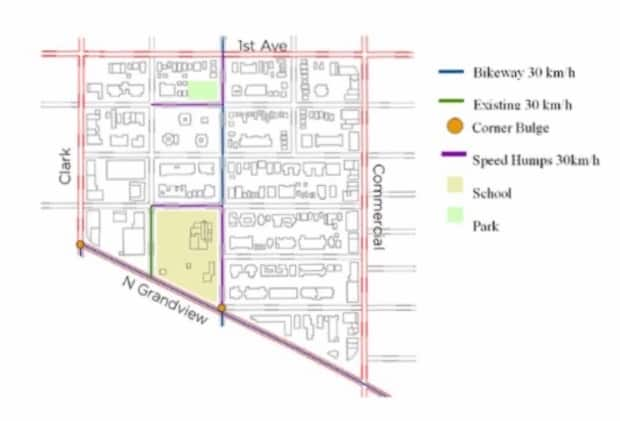Vancouver pilots 30 km/h 'slow zone' in Grandview-Woodland neighbourhood

If you're planning a drive through the heart of Grandview-Woodland any time soon, be prepared to ease off the gas pedal.
Starting Wednesday, a large swath of the neighbourhood becomes the city's first "slow zone" pilot with the speed limit dropping to 30 km/h in the area bounded on the east and west by Clark Drive and Commercial Drive, and on the north and south by First Avenue and Grandview Highway North.
All municipal streets in the province have a default speed limit of 50 km/h unless otherwise posted, but the city says slower speeds could help eliminate traffic-related fatalities and serious injuries.
Studies have shown slowing vehicles dramatically improves safety for people walking and cycling.

According to a World Health Organization study, the probability of a fatality is 15 per cent when a vehicle travelling 30 km/h hits a pedestrian. If the vehicle is going 50 km/h, the probability of fatality increases to 50 per cent.
Grandview-Woodland was identified as a good candidate for the pilot based on speeds, collisions, vulnerable populations (seniors/children/low income) and community amenities.
Signs have been installed to alert drivers to the change.
City staff will monitor the pilot and report back to council in the fall. Information gathered could be used to create more slow zones in Vancouver.
In the summer, the city brought in 24 hour a day 30 km/h zones around schools and playgrounds.
Municipalities advocate for reduced default limits
Winston Chou, manager of the traffic and data management branch with the city, said the provincial Motor Vehicle Act makes projects like this one more challenging than they need to be.
Under the act, municipalities can set their own limits, but they must post signs for each change. According to Chou, an entire area can't have a blanket change applied.
"We're certainly advocating to the province to allow road authorities and local jurisdictions to set default speeds, especially on residential neighbourhoods," he said, calling the requirement to post changes on each block "onerous."
"That can prove to be very expensive and time consuming for staff to do the design work, the cost of the signs, the cost of installation," said Chou.
According to city officials, the Grandview-Woodland pilot project cost $33,000 for just 120 signs, as well as $2,000 for notification letters for residents.
In 2019, the Union of B.C. Municipalities voted to call on the province to make 30 km/h the default provincial limit on streets with no centre line, with posted signs to increase it if desired by municipalities.
In 2016, then-Provincial Health Officer Dr. Perry Kendall released a report that, among other things, recommended the province reduce the default speed limit to 30 km/h.

